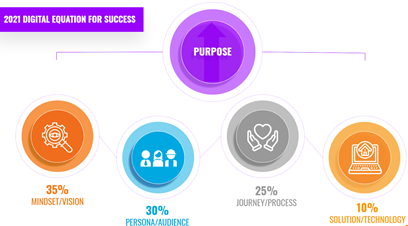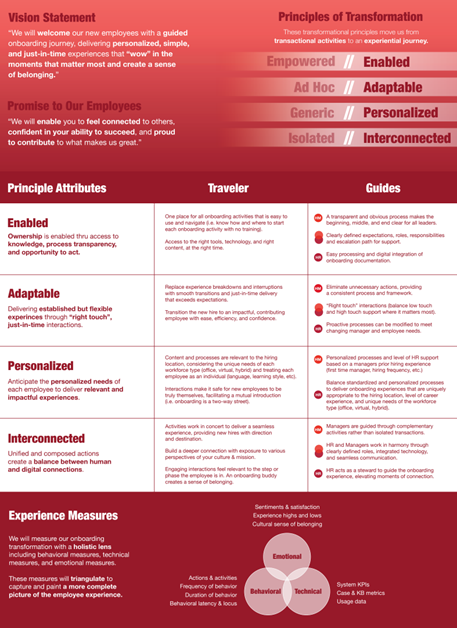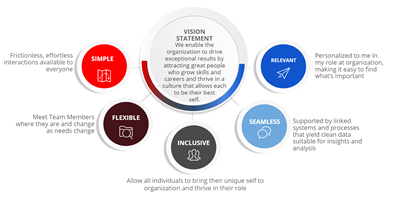Guest post: Thanks to our partnership with Leapgen, we're delighted to have contributions from their team of experts. Thank you to Lynsey Hathcock, Jim Scully, & Elizabeth Whitis for sharing their wealth of knowledge in the field of Digital Employee Experience.
As covered previously in the blog series, organizations are quickly realizing that it is no longer a matter of IF a digital workforce experience is needed but rather, HOW quickly we can transform our operations so we can deliver a digital experience that meets our employees rapidly changing needs.
Unfortunately, for many organizations it can be a very overwhelming process to undertake and one that is starkly different from past outdated deployment experiences.
However, with a clear actionable understanding of where you are trying to go, the move to digital doesn’t have to feel so cumbersome. The right mindset for transformation recognizes technology as fuel; not the vehicle. So how do you get started? First and foremost you have to ensure that your organization has the right mindset for success.
Low code no code platforms remove the need for IT and developer dependency, allowing faster innovation. But how do they fit in with your organization's digital transformation strategy?
A digital journey requires a significantly different approach to technology than the on premise system deployments of the past. As a result, when going digital it’s important you are going in with a bold perspective and that you have the right equation for success. Digital transformation changes the way people work and drives business outcomes never before realized.

Organizations need to link day-to-day-work with our larger purpose. An elevated workforce experience boosts employee morale, drives engagement, increases performance, accelerates business, and retains both talent and customers.
Let’s drill into the key elements of the framework:
Mindset/Vision: When setting your digital experience you must first understand where you are trying to go and how you are going to get there.
Persona/Audience: After a clear vision is set, we focus on people: how do they support the end state, and how will the journey ahead impact them.
Journey/Process: Knowing that informs decisions about how to improve the experience for the audience through processes.
Solution/Technology: The last component is technology -- while this technology makes it easier on those with limited experience to build and connect solutions for both web-based and mobile, it is truly the last portion of the equation. By leading with a clear vision and understanding the people and processes that need to evolve, the technology will naturally reveal itself.
This equation for success is often a new approach for many organizations who are more accustomed to leading with technology first. When you undertake a ‘digital workforce journey’ it can be easy to focus solely on what technology is required to support the future state.
However, in reality when you set a clear vision, understand your people and their needs and design an experience to meet their needs, the technology is simply the tool that brings the experience to life. Let’s take a look at how establishing a vision can ensure success in delivering your ideal digital experience.
Mindset/ Vision
Establishing your vision is the first step to ensuring a successful digital transformation. A digital mindset is one where you have accepted and are fully committed to the change that is needed to create and sustain meaningful transformation. Your technology strategy will stay heavily bolted to the North Star that is your digital vision. This is the opportunity to bring key leaders across your organization and determine what we want our digital experience to be. The output of this is a ‘Vision Map’ and this serves as a guiding force on your digital journey, ensuring that you have an ideal future state identified to serve as a guiding star as you make decisions.
A vision map captures a number of critical details:

Vision statement: This is a declaration of what you are trying to accomplish and how this will deliver value to your organization.

Guiding Principles: This is a framework of rules and values that add context to the story and guides decision making.
Experience Attributes: How will things look and feel to different workforce personas.
Measures: How you define success and drive accountability in alignment with the vision and guiding principles.
This vision map helps to establish what your future of work will look like, and defines what makes a successful digital experience. When done correctly, the vision map will provide guardrails for you as you make critical decisions over the course of your deployment.
This will be used to hold you accountable; when you begin to add in cumbersome approvals, unnecessary exceptions to processes, this is where you can use your vision map to challenge yourself.
Ask yourself, if this decision will meet the desired experience attribute? Is the solution you are designing going to deliver the vision you wanted to establish?
Depending on the complexity of your business, digital transformation will likely be a multi-year journey with true aspirations to change work for good. It will include several phases of smaller transformations with unique and specific visions; the broadest digital people vision will remain bold and anchored in a better experience for the future.
After you have established your vision, you then can begin bringing your vision to life. In future articles we will dive into the people, journey and technology components, including the key elements of a “low code, no code” workforce experience platform investment) that is required to help ensure your vision is achieved.
About the Authors
Lynsey Hathcock is a seasoned management consultant at Leapgen with over ten years of HR strategy, design thinking and change enablement experience. Lynsey is passionate about finding innovative ways to help clients craft impactful experiences for their people to ensure intended business outcomes are realized.
Lynsey has successfully led 25+ Fortune 500 clients to solve complex organizational problems; including digital transformations, global system implementations and talent management initiatives. She brings diverse industry experience- spanning across retail, pharmaceuticals, financial services, education and non-profit.
Lynsey holds a Juris Doctor and Masters of Business Administration degree from Wake Forest University and a Bachelor’s degree in Political Science and Economics from Clemson University.
Jim Scully is a recognized industry expert in the design and optimization of HR service operations. With nearly 25 years of related professional experience, both as a consultant and practitioner, plus extensive practice research as founder of the HR Shared Services Institute, Jim has unparalleled expertise in the field of HR shared services and service operations at Leapgen. In addition, Jim brings operational excellence background, including TQM, Lean, Six Sigma and Theory of Constraints (TOC) to the realm of HR service delivery to go beyond mere consolidation to create what he calls the “Delivery Center of Excellence.” Jim holds a B.A. in Philosophy and M.S. in Management from the University of Missouri and Georgia State University, respectively.




-1.png?width=420&height=134&name=applaud_award_logos_aug2021_img%20(1)-1.png)